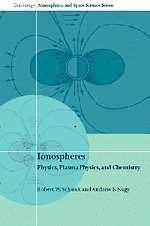Book contents
- Frontmatter
- Contents
- Chapter 1 Introduction
- Chapter 2 Space Environment
- Chapter 3 Transport Equations
- Chapter 4 Collisions
- Chapter 5 Simplified Transport Equations
- Chapter 6 Wave Phenomena
- Chapter 7 Magnetohydrodynamic Formulation
- Chapter 8 Chemical Processes
- Chapter 9 Ionization and Energy Exchange Processes
- Chapter 10 Neutral Atmospheres
- Chapter 11 The Terrestrial Ionosphere at Middle and Low Latitudes
- Chapter 12 The Terrestrial Ionosphere at High Latitudes
- Chapter 13 Planetary Ionospheres
- Chapter 14 Ionospheric Measurement Techniques
- Appendices
- Index
Chapter 14 - Ionospheric Measurement Techniques
Published online by Cambridge University Press: 06 January 2010
- Frontmatter
- Contents
- Chapter 1 Introduction
- Chapter 2 Space Environment
- Chapter 3 Transport Equations
- Chapter 4 Collisions
- Chapter 5 Simplified Transport Equations
- Chapter 6 Wave Phenomena
- Chapter 7 Magnetohydrodynamic Formulation
- Chapter 8 Chemical Processes
- Chapter 9 Ionization and Energy Exchange Processes
- Chapter 10 Neutral Atmospheres
- Chapter 11 The Terrestrial Ionosphere at Middle and Low Latitudes
- Chapter 12 The Terrestrial Ionosphere at High Latitudes
- Chapter 13 Planetary Ionospheres
- Chapter 14 Ionospheric Measurement Techniques
- Appendices
- Index
Summary
This chapter describes the various measurement techniques that are directly applicable to the determination of ionospheric parameters. This discussion is restricted to the most commonly used methods, which measure the thermal plasma densities, temperatures, and velocities. In general, these techniques can be grouped as remote or direct (in situ) ones. Topics related to direct measurement techniques are described in the first four sections and the rest of the chapter deals with remote sensing. The remote, radio sensing methods rely on the fact that the ionospheric plasma is a dispersive media (Section 6.8) while the relevant radar measurements use the reflective properties of the plasma. The direct in-situ measurement techniques discussed here are restricted to those that are applicable to altitudes where the mean-free-path is greater than the characteristic dimension of the instrument.
Spacecraft Potential
In situ measurements of ionospheric densities and temperatures are based on the laboratory technique developed and discussed by Irving Langmuir and co-workers over seventy years ago. These so-called Langmuir probes, or retarding potential analyzers (RPAs), had been used for many years in laboratory plasmas before they were adopted for space applications. On a rocket or a satellite, the voltage applied to an instrument has to be driven against the potential of the vehicle, and therefore, it is appropriate to begin with a discussion of the factors that affect the value of this potential.
- Type
- Chapter
- Information
- IonospheresPhysics, Plasma Physics, and Chemistry, pp. 464 - 488Publisher: Cambridge University PressPrint publication year: 2000

